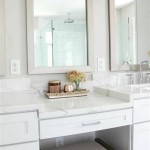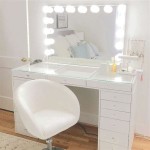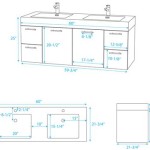Converting a Single Vanity to a Double Vanity: A Comprehensive Guide
Homeowners often seek to enhance the functionality and aesthetic appeal of their bathrooms. One common remodeling project involves replacing a single vanity with a double vanity. A double vanity provides increased counter space, storage, and convenience, particularly in shared bathrooms. This conversion, however, is not a simple swap and requires careful planning, assessment of existing conditions, and potentially, professional assistance. This article provides a detailed guide on how to approach this conversion, covering key considerations and necessary steps.
The decision to convert from a single to a double vanity should be driven by a genuine need for more space and functionality. Simply wanting a larger vanity without considering the structural and plumbing implications can lead to costly errors and unmet expectations. Before embarking on the project, it is crucial to evaluate the bathroom's dimensions, existing plumbing infrastructure, and electrical setup. Furthermore, consider the long-term impact on the room's layout and whether the increased size of the vanity will compromise the overall flow and accessibility of the bathroom.
Evaluating Existing Space and Layout
The first critical step is to accurately measure the existing bathroom space. This includes the width, depth, and height of the area where the vanity will be located. Precise measurements are essential for selecting the appropriate size of the double vanity and ensuring it fits comfortably within the bathroom without overcrowding the space. Consider the swing of the bathroom door, the placement of the toilet, and the location of any existing fixtures. Ideally, there should be ample space around the vanity for comfortable movement and use.
Visualizing the new double vanity in relation to existing fixtures is crucial. Mockups, either physical or digital, can help in understanding the spatial impact. A cardboard cutout or a 3D rendering can provide a clear picture of how the double vanity will integrate into the existing layout. Pay close attention to the proximity of the vanity to the toilet, shower, and other essential elements. Ensure that there is sufficient clearance for doors and drawers to open and close freely. This step can prevent disappointment and costly adjustments later in the project.
Furthermore, beyond the immediate area surrounding the vanity, assess the wider bathroom layout. Consider how the increased size and potential change in traffic flow will affect the overall usability of the space. Is there sufficient storage elsewhere in the bathroom to accommodate the items currently stored in the single vanity? If not, the double vanity may need to incorporate additional storage solutions to compensate for the displaced items. Careful consideration of these factors will contribute to a successful and functional bathroom renovation.
Assessing Plumbing and Electrical Infrastructure
One of the most significant challenges in converting a single to a double vanity is the plumbing. Typically, a single vanity is served by a single set of water supply lines and a single drain line. A double vanity generally requires two sets of supply lines and often, though not always, two separate drain lines. This entails extending existing plumbing or installing new lines, which can involve opening walls and floors.
Examine the existing plumbing configuration. Identify the location of the main water supply lines and the drain line for the sink. Determine whether the existing plumbing is accessible and whether it can be easily extended to accommodate the double vanity. If the existing plumbing is old or corroded, it may be necessary to replace it entirely rather than simply extending it. This adds to the cost and complexity of the project, but it can prevent future plumbing problems.
Electrical considerations are equally important. Determine the availability of electrical outlets near the vanity. Many modern double vanities include features such as built-in lighting, power outlets for hair dryers and styling tools, and even USB charging ports. If these features are desired, additional electrical outlets may need to be installed. This requires the services of a qualified electrician to ensure that the wiring is up to code and that the electrical system can handle the increased load. Inadequate electrical capacity can lead to overloaded circuits and potential fire hazards.
It is highly recommended to consult with a licensed plumber and electrician before beginning the conversion. They can assess the existing plumbing and electrical infrastructure, identify potential challenges, and provide recommendations for the best approach. Their expertise can help to avoid costly mistakes and ensure that the project is completed safely and according to code.
Selecting the Right Double Vanity
Choosing the right double vanity is a crucial decision that impacts both the aesthetics and functionality of the renovated bathroom. The selection process should consider not only the style and appearance of the vanity but also its size, storage capacity, and construction quality. A well-chosen vanity will enhance the overall look and feel of the bathroom while providing ample storage and a comfortable user experience.
Consider the available space when selecting the size of the double vanity. Opting for a vanity that is too large can make the bathroom feel cramped and uncomfortable, while a vanity that is too small may not provide sufficient counter space or storage. Accurate measurements of the available space are essential for choosing a vanity that fits perfectly. Also, keep in mind the standard height of a vanity which is usually around 30-36 inches, but can be adjusted based on your personal preferences and ergonomic considerations.
Storage capacity is another important factor to consider. Assess the types of items that will be stored in the vanity and choose a model that provides adequate storage space. Options include drawers, cabinets, and open shelving. Drawers are ideal for storing smaller items such as toiletries and cosmetics, while cabinets are better suited for larger items such as towels and cleaning supplies. Open shelving can be used to display decorative items or store frequently used items. The configuration of storage should also align with individual needs and preferences; for instance, individuals sharing the vanity may prefer separate, clearly defined storage spaces.
The construction quality of the double vanity is paramount for its longevity and durability. Look for vanities made from high-quality materials such as solid wood, plywood, or MDF (medium-density fiberboard) with a durable finish. Avoid vanities made from cheap particleboard, as they are prone to moisture damage and will not last as long. The hardware, such as hinges and drawer slides, should also be of good quality to ensure smooth and reliable operation. Solid construction and durable materials will ensure that the double vanity withstands daily use for many years to come.
Style is, of course, a critical consideration. The double vanity should align with the overall design aesthetic of the bathroom. Choose a style that complements the existing fixtures, tile, and paint colors. Options range from traditional to contemporary, minimalist to ornate. Consider the hardware finish, countertop material, and sink style when making your selection. Consistency in style will create a cohesive and visually appealing bathroom.
Finally, budget considerations are important. Double vanities range widely in price, depending on the size, materials, construction quality, and features. Establish a budget before beginning the shopping process and stick to it. It is often worthwhile to invest in a higher-quality vanity that will last longer and provide a better user experience, even if it means spending a bit more. Look for sales and discounts to get the best value for your money.
By carefully evaluating the existing space, plumbing, and electrical infrastructure, and by selecting the right double vanity, homeowners can successfully transform their bathrooms into more functional and aesthetically pleasing spaces. While this conversion may require professional assistance, careful planning and attention to detail will ensure a successful outcome.

How We Easily Converted A Single Sink To Double

Double Vanity Do It Yourself Install Single To How A Bathroom

Updated Bathroom Single Sink Vanity To Double Remodelaholic

Single To Double Vanity Better Way Illinois

Replacing A Single With Double Sink Vanity Unique Vanities

How To Make A Double Sink In Your Home Bathroom Remodel Diy

Replacing A Single With Double Sink Vanity Unique Vanities

Antique Bathroom Vanity For Single Or Double Sink We Custom Convert From Furniture You Reno Remodeling 61 To 66 Wide Etsy Canada

Converting From A Double Vanity To Single Rough Plumbing

Antique Bathroom Vanity Double Or Single We Custom Convert From Furniture For You Victorian Farmhouse Reno 61 To 66 Wide Long Etsy







